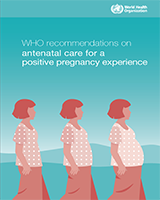Background
Pregnancy requires a healthy diet that includes an adequate intake of energy, protein, vitamins and minerals to meet maternal and fetal needs. However, for many pregnant women, dietary intake of vegetables, meat, dairy products and fruit is often insufficient to meet these needs, particularly in low- and middle-income countries (LMICs) where multiple nutritional deficiencies often co-exist. In resource-poor countries in sub-Saharan Africa, south-central and south-east Asia, maternal undernutrition is highly prevalent and is recognized as a key determinant of poor perinatal outcomes (31). However, obesity and overweight is also associated with poor pregnancy outcomes and many women in a variety of settings gain excessive weight during pregnancy. While obesity has historically been a condition associated with affluence, there is some evidence to suggest a shift in the burden of overweight and obesity from advantaged to disadvantaged populations (32).
Anaemia is associated with iron, folate and vitamin A deficiencies. It is estimated to affect 38.2% of pregnant women globally, with the highest prevalence in the WHO regions of South-East Asia (48.7%) and Africa (46.3%), medium prevalence in the Eastern Mediterranean Region (38.9%) and the lowest prevalence in the WHO regions of the Western Pacific (24.3%), the Americas (24.9%) and Europe (25.8%) (33).
Major contributory factors to anaemia include parasitic infections such as malaria, hookworm and schistosomiasis, in areas where these infections are endemic. In addition, chronic infections such as tuberculosis (TB) and HIV, and haemoglobinopathies such as sickle-cell disease, contribute to the prevalence of anaemia. It is estimated that 0.8 million pregnant women globally have severe anaemia (defined as a blood haemoglobin concentration < 70 g/L) (33). In pregnancy, severe anaemia is associated with an increased risk of maternal and infant mortality (34). It is estimated that about half of the anaemia found in pregnant women is amenable to iron supplementation (33); however, this may be quite variable and is likely to be much lower in malaria-endemic areas.
In addition to causing anaemia, iron deficiency adversely affects the use of energy sources by muscles and, thus, physical capacity and work performance, and also adversely affects immune status and morbidity from infections (35). Folate (vitamin B9) deficiency, in addition to anaemia it is also linked to fetal neural tube defects (36). Vitamin A deficiency affects about 19 million pregnant women, mostly in Africa and South-East Asia, causing night blindness (37).
Calcium deficiency is associated with an increased risk of pre-eclampsia (38), and deficiencies of other vitamins and minerals, such as vitamin E, C, B6 and zinc, have also been postulated to play a role in pre-eclampsia. Zinc deficiency is associated with impaired immunity (39). Vitamin C intake enhances iron absorption from the gut; however, zinc, iron and other mineral supplements may compete for absorption, and it is unclear whether such interactions have health consequences (39).
For the ANC guideline, the GDG evaluated the evidence on various vitamin and mineral supplements that might theoretically lead to improved maternal and perinatal outcomes. In addition, as both undernourishment and overnourishment may have negative consequences for pregnant women and their babies, the GDG also evaluated evidence on the effects of various dietary interventions to reduce the impact of these conditions. Caffeine is possibly the most widely used psychoactive substance in the world (40), and the GDG also evaluated evidence on the impact, if any, of caffeine restriction during pregnancy.
Women’s values
A scoping review of what women want from ANC and what outcomes they value informed the ANC guideline (13). Evidence showed that women from high-, medium- and low-resource settings valued having a positive pregnancy experience, the components of which included the provision of effective clinical practices (interventions and tests, including nutritional supplements), relevant and timely information (including dietary and nutritional advice) and psychosocial and emotional support, by knowledgeable, supportive and respectful health-care practitioners, to optimize maternal and newborn health (high confidence in the evidence).

